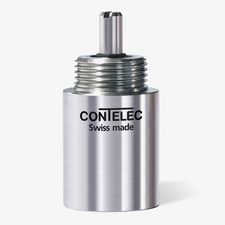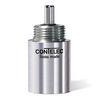High-precision 3D measurements
Contelec’s Vert-X 13 represents a new benchmark in probes for the multidimensional measurement of surfaces.
Precision, multi-dimensional mechanical measurement of surfaces using 3D probes is a demanding challenge. The object is to achieve maximum accuracy and repeatability of travel to the index positions of the probe head along the x and y axes and ensure mechanical locking.
Up until now, solutions have used potentiometric rotary encoders to achieve precise angle positions. While these have proven their value in daily use, their performance features only allow probe heads with 5° spacing between the index positions – and this is inadequate for many applications.
Contactless Vert-X technology
Contactless rotary encoders based on Vert-X technology offer the ideal way to minimize the spacing of the index positions. Their accuracy and long-term stability significantly outperform potentiometers. In the standard configuration, however, they have one disadvantage: because of their direct proximity to the DC motors installed offset at 90° in the probe heads, the magnets in the rotary encoders and motors exert a reciprocal influence. This leads to signal distortion and unsatisfactory results.
To address this problem, Contelec has developed a solution tailored to the specific needs of 3D probe heads. This allows probe heads with 2.5° latching index positions, half the increment offered by previous solutions.
Rotary sensor with effective shielding
Contelec developed effective shielding to prevent reciprocal interference between the motor and rotary encoder magnets. This allows sensitive, high-precision angle measurements to be made in the proximity of motors, other rotary encoders and permanent magnets.
The solution the company came up with can be implemented in what is currently the smallest format, Vert-X 13, but can also be scaled up for larger rotary sensors with a mounted shaft. Contelec has filed a patent for the solution, which features a new magnet arrangement involving the integration of a ring magnet in a ferromagnetic rotational body with integral axis (“bell design”).
The field of the ring magnet is so efficiently focused by the rotational body that interference emanating from the magnet to the outside is minimized and there is virtually no interaction with the magnetically screening rotary encoder housing.
On the one hand this prevents any potential magnetic hysteresis effects. On the other, the full saturation field strength of the ferromagnetic housing is available to absorb external interference. It is even able to shield effectively against increased interference fields such as those caused by motors, for example. Interference field sensitivity was reduced by a factor of 5.

